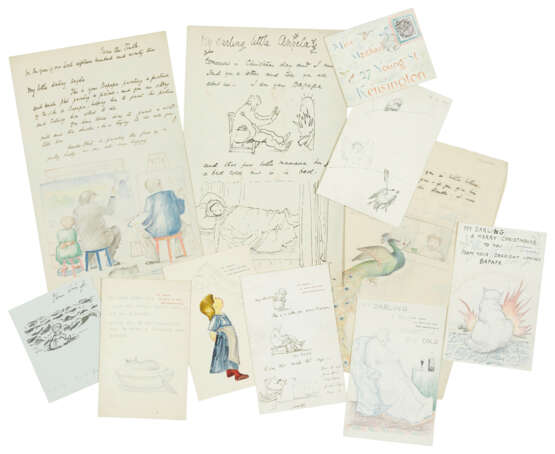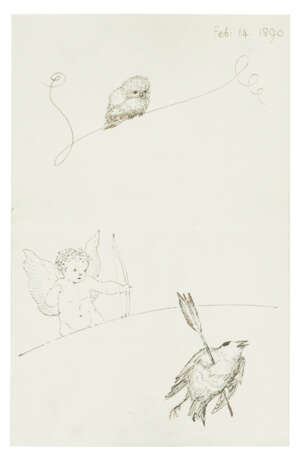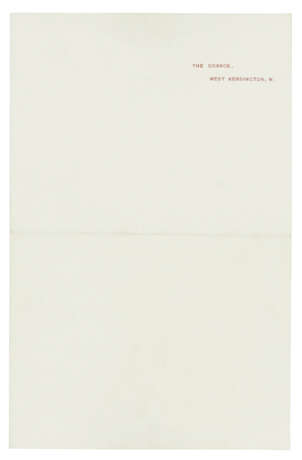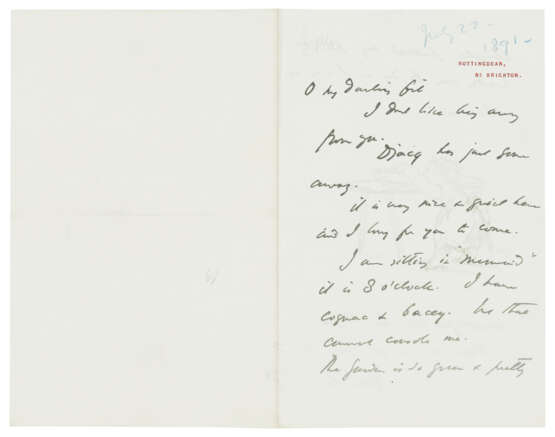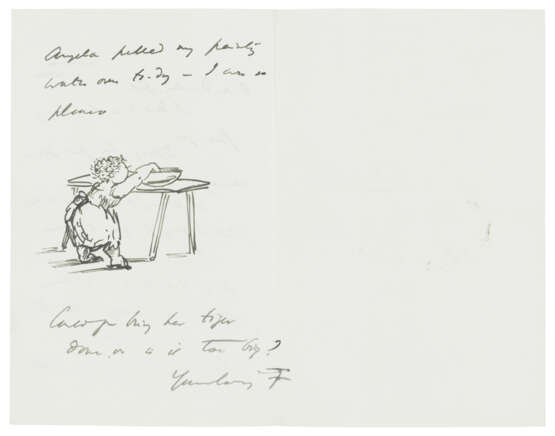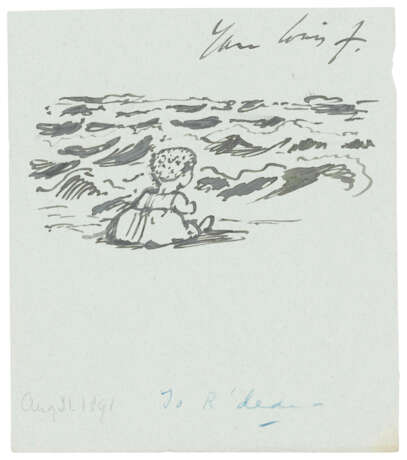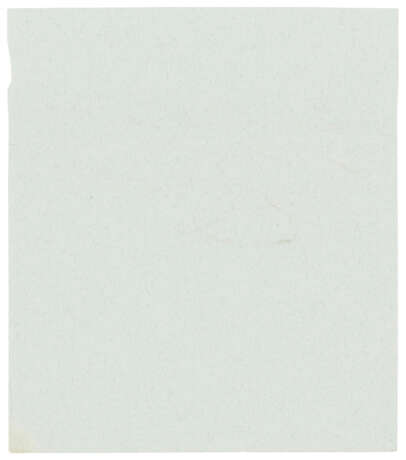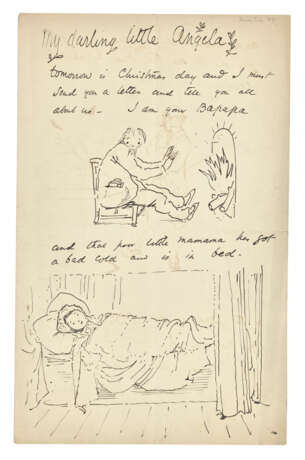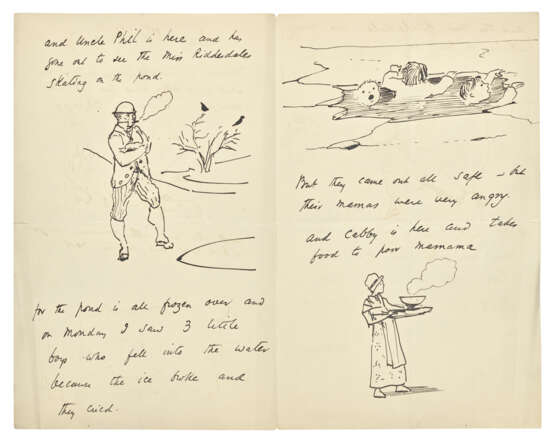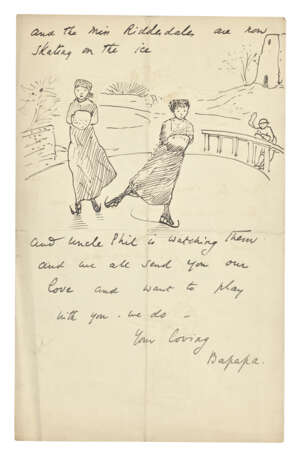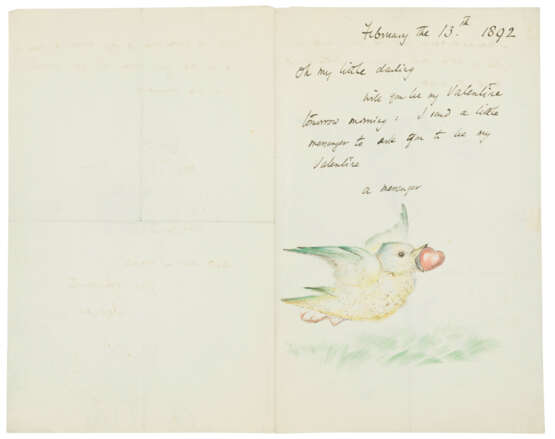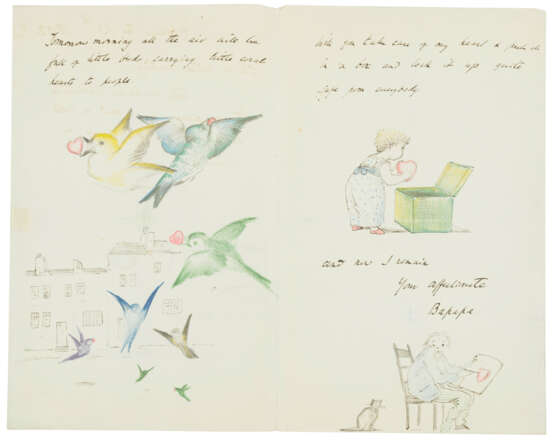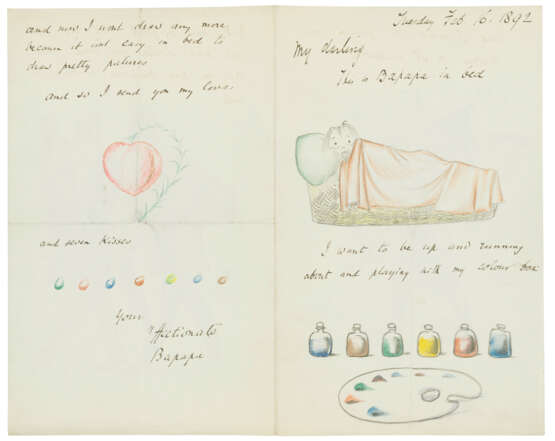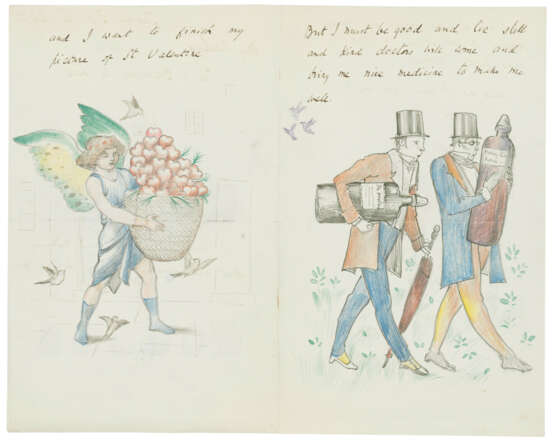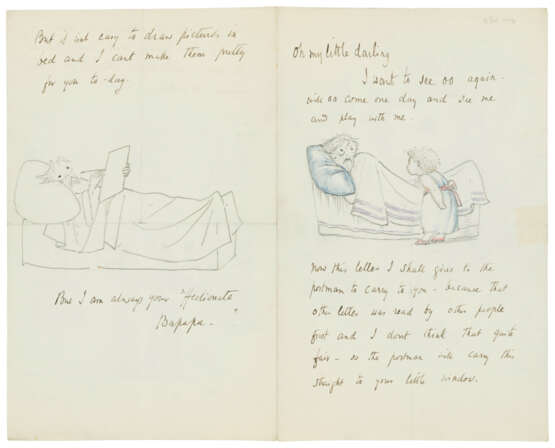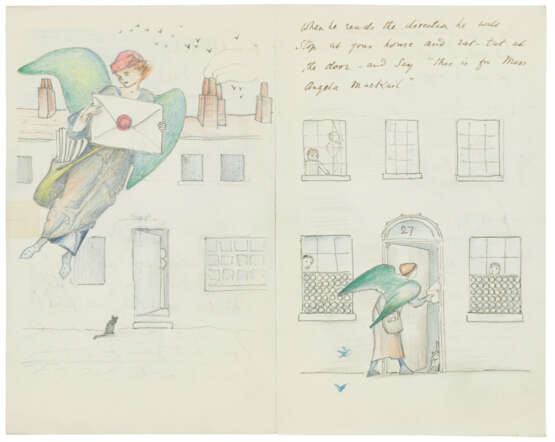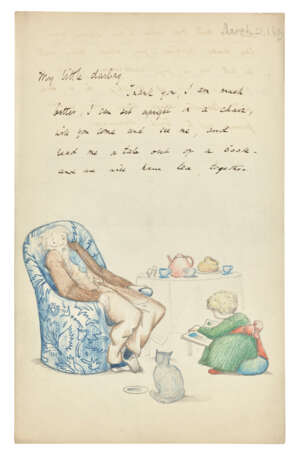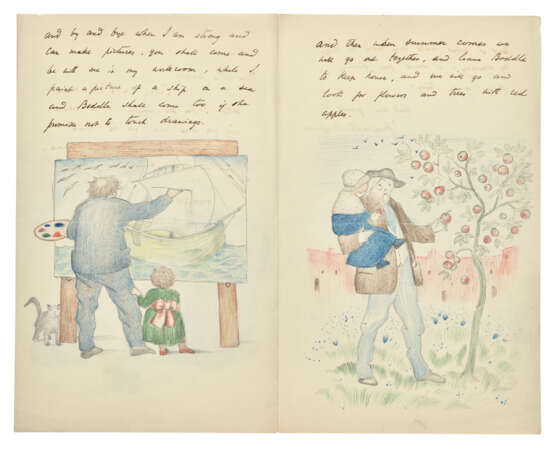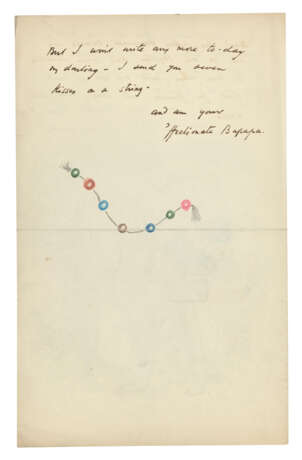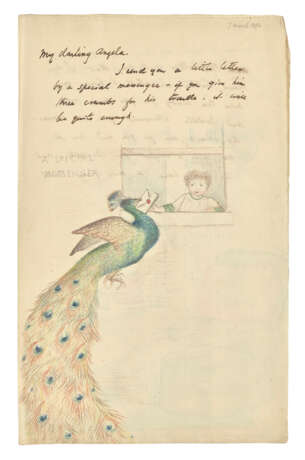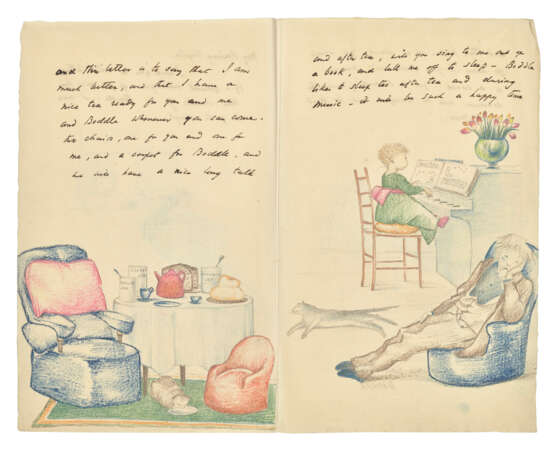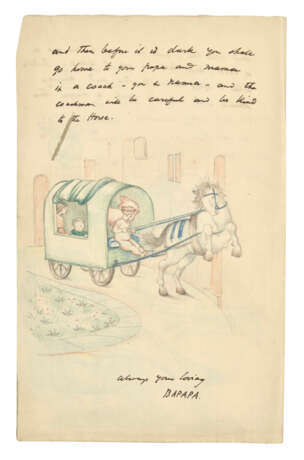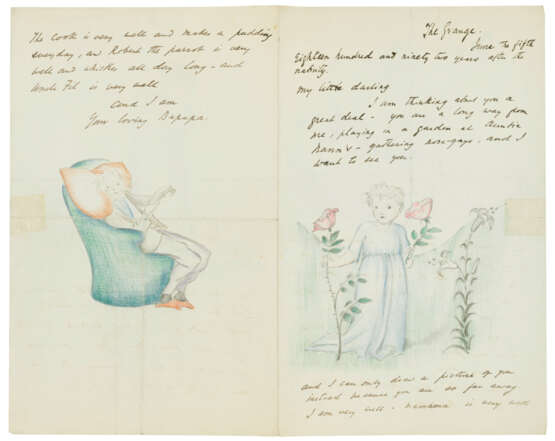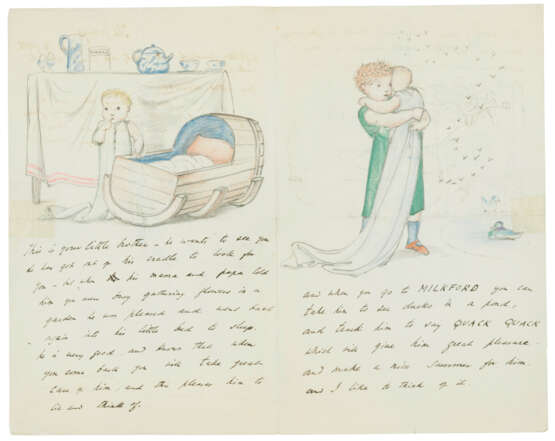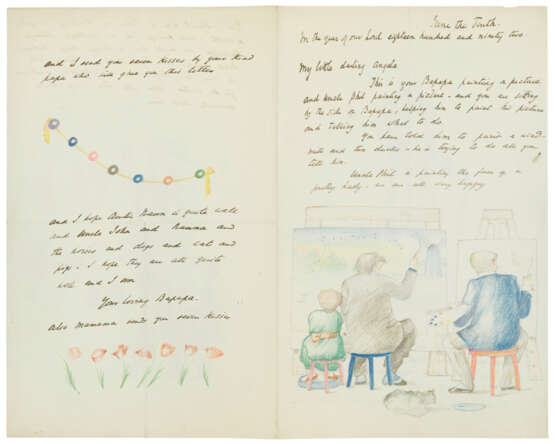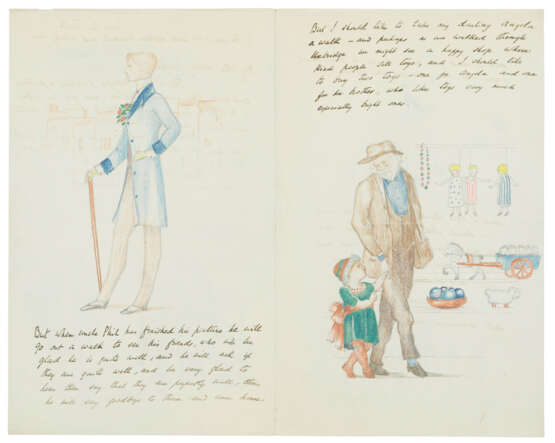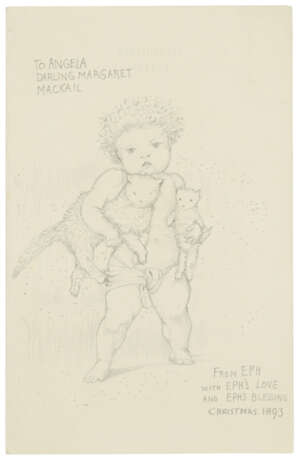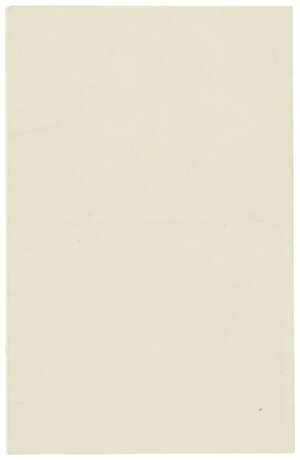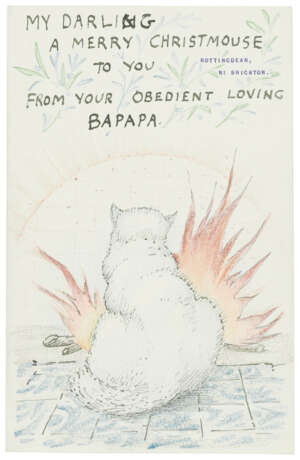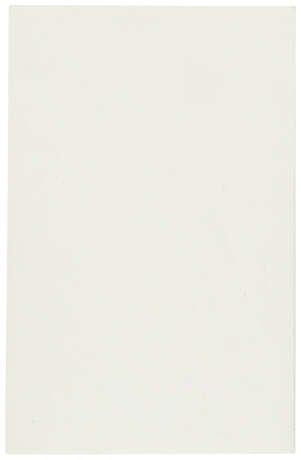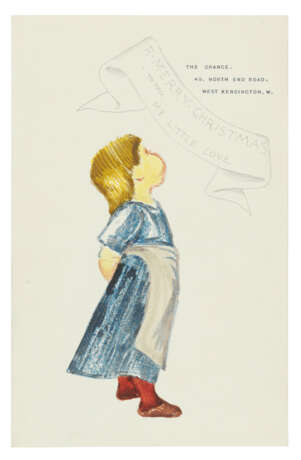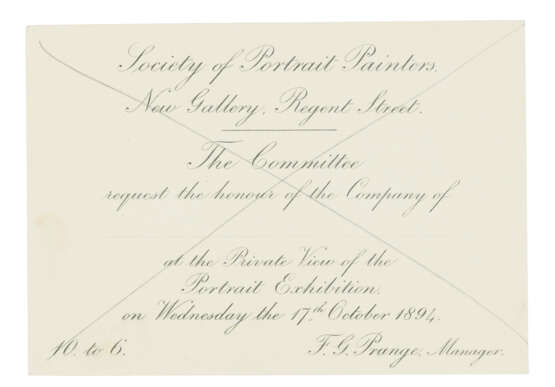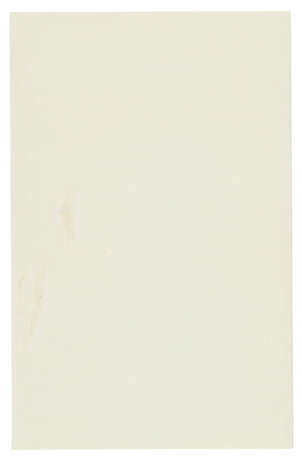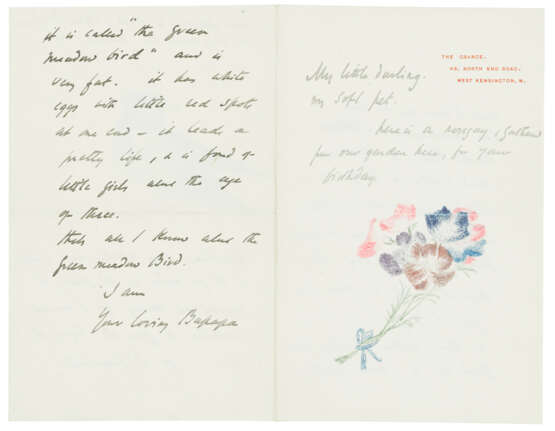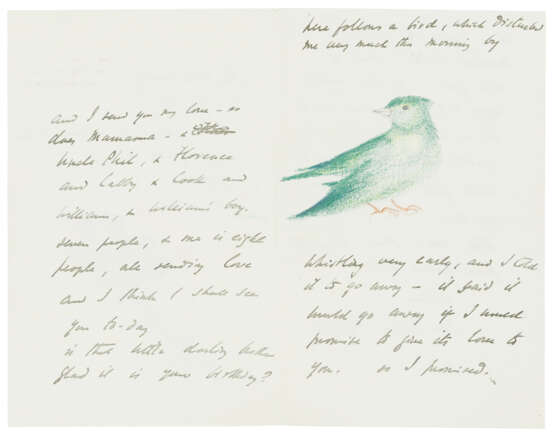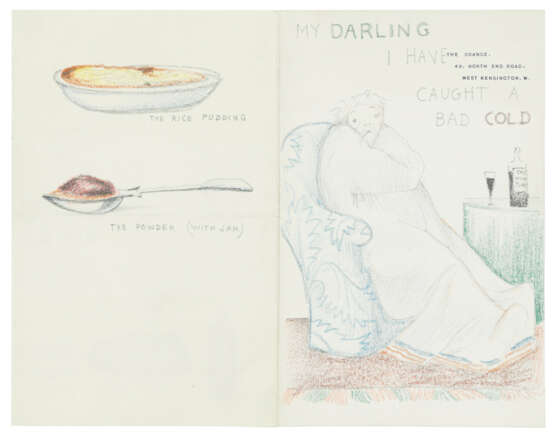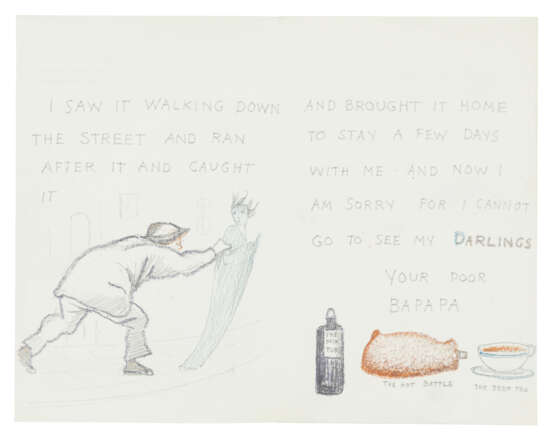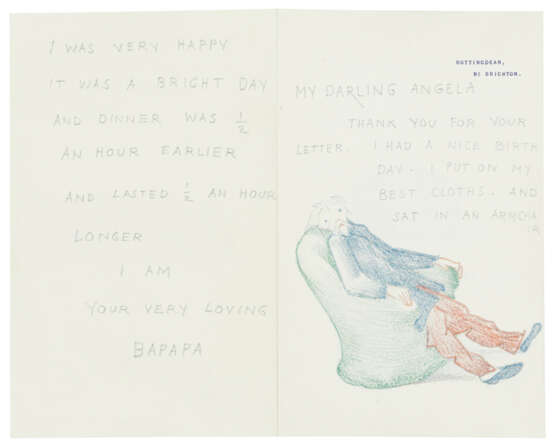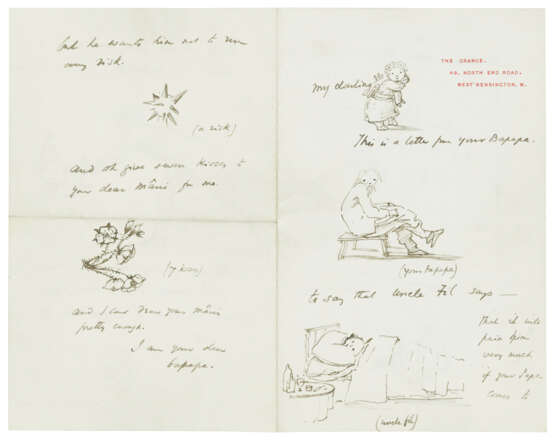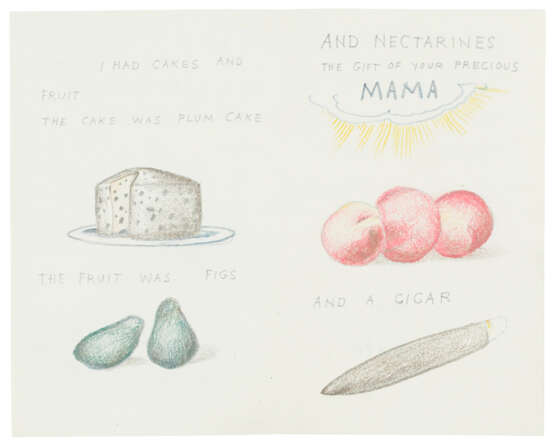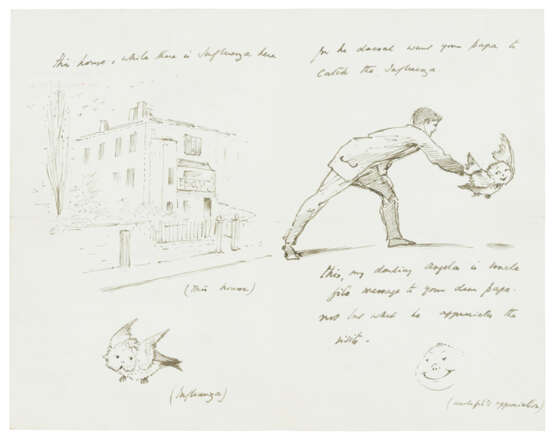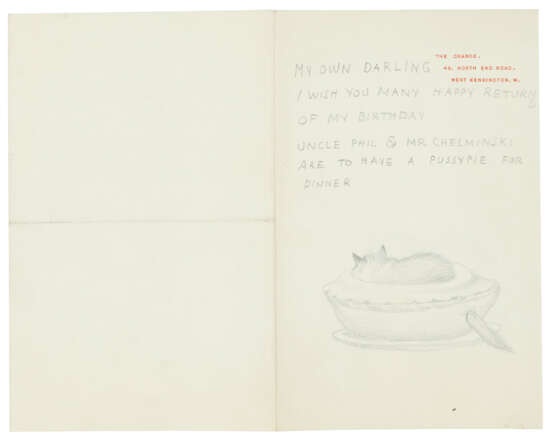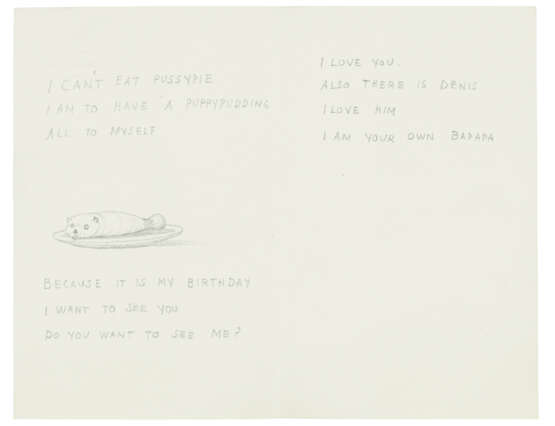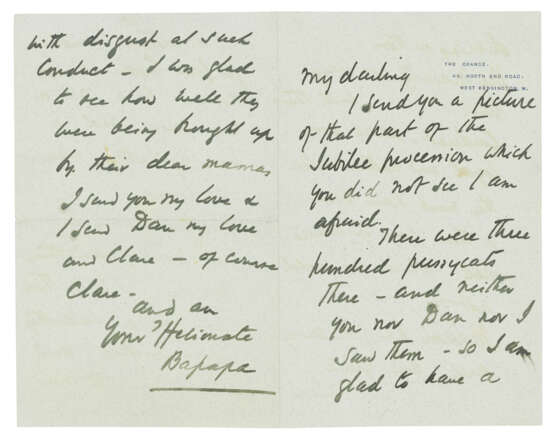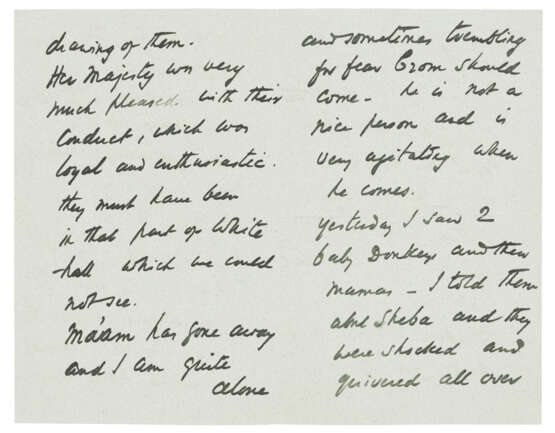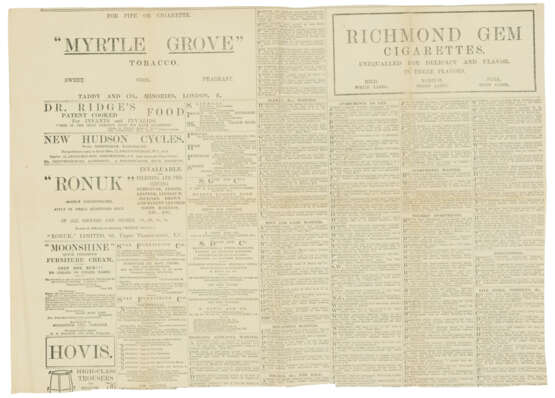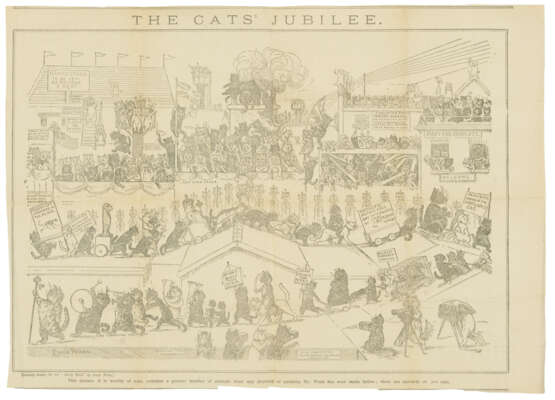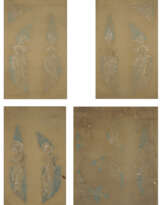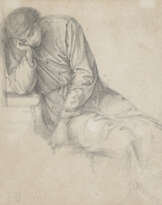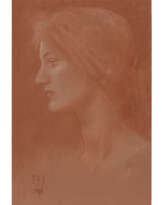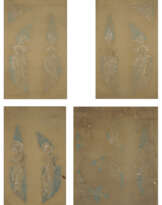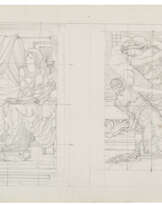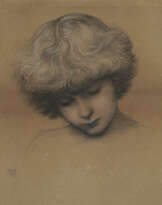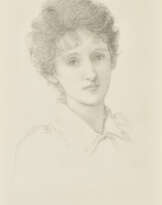ID 1349686
Lot 93 | Sir Edward Coley Burne-Jones, Bt, A.R.A., R.W.S. (1833-1898)
Valeur estimée
£ 30 000 – 50 000
20 autograph letters and cards, of which 19 are illustrated, to the artist's granddaughter Angela Thirkell (one apparently to her mother, his daughter Margaret), Rottingdean, West Kensington and n.p., 14 February 1890 – Christmas 1893 and n.d.
Various sizes (between 12.7 x 11.4 cm. and 32.3 x 20.3 cm.), including three Christmas cards, three birthday cards and three Valentine’s cards, 12 illustrated in coloured pencil, five illustrated in pen and ink, two illustrated in pencil, one not illustrated. With 7 envelopes (11.7 x 24.1 cm, and smaller), in a folio; with a newspaper cutting including a print of Louis Wain's 'The Cats’ Jubilee'. Provenance: by descent from Angela Thirkell.
Delightful, humorous illustrated letters for his granddaughter. Burne-Jones's enduring habit of illustrating his letters with comical drawings began with his own children in the 1860s, and already featured the chubby babies, farmyard animals, birds and invented creatures that feature here, as well as the self-portraits as a shabby, gaunt figure that became almost a signature. The letters in the present lot are unusual for their larger format and vivid colouring: their text complements the drawings, in a style suitably adapted for the age of the recipient, as with a drawing of a bird, accompanied by the commentary 'it is called “the green meadow bird” and is very fat. It has white eggs with little red spots at one end – it leads a pretty life, & is fond of little girls above the age of three. That’s all I know about the green meadow Bird'; or two self-caricatures of a sickly Burne-Jones, in the second running after a blue ghoulish figure, 'My darling, I have caught a bad cold ... I saw it walking down the street and ran after it and caught it'. The unillustrated letter accompanies a cutting of Louis Wain's 'The Cats' Jubilee' (presumably written after Queen Victoria's Diamond Jubilee, 20 June 1897), 'I send you a picture of that part of the Jubilee procession which you did not see I am afraid. There were three hundred pussycats there – and neither you nor Dan nor I saw them – so I am glad to have a drawing of them. Her Majesty was very much pleased with their conduct, which was loyal and enthusiastic. They must have been in that part of Whitehall which we could not see...'. The recipient is Burne-Jones's eldest granddaughter, Angela Thirkell (née Mackail, 1890-1961), a particular favourite, later a prolific and successful author, including of memoirs of her childhood and grandfather.
The subjects of the illustrated letters and cards comprise:
Dated:
i) 14 February 1890: a bird sitting on a curling line, under which a winged cupid with a bow, and to the right, a bird hit clean through with an arrow, the tail facing upwards.
ii) [22 July 1891]: Angela reaching up to put her hand in a bowl of painting water between the lines of text.
iii) 31 August 1891: a child in a dress seated on the sand facing the sea.
iv) [24 December 1891]: the artist warming his hands in front of the fire, and his wife in bed; a man standing smoking beside a pond; three small boys emerging from a hole in the ice, above, and another of a woman carrying a tray with a steaming bowl, below; two young women skating on a pond, watched by a man smoking (between the lines of the text).
v) 13 February 1892: a small green and yellow bird carrying a heart in its beak below; several birds carrying hearts in their beaks, in a street of houses, below; Angela putting a heart into a box between the lines of text, and a self-portrait painting a heart below.
vi) 16 February 1892: a self-portrait in bed between the lines of text, and a drawing of paint bottles and palette below; St Valentine holding a basket of hearts and surrounded by small birds below; two doctors carrying oversized medicine bottles below; a heart on a stem and seven coloured beads between the lines of text.
vii) [19 February 1892]: a self-portrait lying in bed, with Angela standing beside, between the lines of text; an angel holding an oversized envelope, in front of a house with a black cat on the pavement, and a blank figure opening the door on the left hand page, and the angel handing the letter through the door, with several figures looking through the windows of the house on the right hand page.
viii) [2 March 1892]: a self-portrait in an armchair beside a tea table, Angela sitting on the floor reading, and a cat listening in the centre, below; a self-portrait from behind at a canvas, with Angela beside, and a cat to the left, below; a self-portrait carrying Angela picking fruit from an apple tree below; seven coloured beads on a string below.
ix) [7 March 1892]: a peacock with a flowing tail passing a letter through a window to a small girl below; a tea table with two armchairs beside, and a cat drinking from a saucer between them; a self-portrait asleep in an armchair, beside Angela playing the piano, with a cat asleep on the floor, below; a horse and carriage being driven by a cherub, with Angela looking through the window, between the lines of text.
x) 5 June 1892: Angela picking flowers in a garden, wearing a blue dress, between the lines of text; a small child standing beside a cradle and a breakfast table above; Angela holding a baby beside a duck pond above; a self-portrait seated in an armchair, reading a letter below.
xi) 10 June 1892: a self-portrait from behind at a canvas, Philip Burne-Jones to the right and Angela to the left, a cat on the floor behind, below; Philip Burne-Jones, in an elegant tailcoat and carrying a cane, above; a self-portrait in a brown suit, holding Angela’s hand and passing a toyshop window, below; a drawing of seven red balls on a string between the lines of text, and one of seven red flowers below.
xii) 25 December 1893: a child in a loincloth holding a cat under each arm between the two lines of text.
Undated:
xiii) a cat looking at a fire.
xiv) a little girl in a blue dress and white apron, standing in profile below; with an invitation for ‘Society of Portrait Painters’ with a large pencil cross out mark over the invitation.
xv) a posy of flowers; a small green bird.
xvi) a self-portrait seated in a chair, wrapped in a blanket, a bottle labelled ‘THE MIXTUR[E]’ on a side table; a man catching a blue ghoulish figure below; medicine, a hot water bottle and a cup of beef tea below, inscribed ‘THE MIXTURE / THE HOT BOTTLE / THE BEEF TEA’; a dish of rice pudding and a spoon of jam.
xvii) a self-portrait seated in an armchair below; a fruit cake and a drawing of two figs; three nectarines; a cigar.
xviii) three drawings of Angela, Burne-Jones, and Philip Burne-Jones in bed; The Grange, seen from North End Road, and a bird representing influenza below; a man catching the influenza bird, and another of a round smiling face; a spiked ball representing risk, and seven roses representing seven kisses.
xix) a cat sunk within the centre of a pie, its face turned away from the viewer, and its tail emerging through a hole in the lower right pie crust below; a puppy wrapped up on a plate between the lines of text.
Exhibited
xvi) London, Tate Britain, Edward Burne-Jones, 24 October 2018 - 24 February 2019, no. 88.
| Artiste: | Edward Burne-Jones (1833 - 1898) |
|---|---|
| Lieu d'origine: | Europe du Nord, Europe, Royaume-Uni |
| Catégorie maison de vente aux enchères: | Peintures, Aquarelles, Dessins, Aquarelles et dessins |
| Artiste: | Edward Burne-Jones (1833 - 1898) |
|---|---|
| Lieu d'origine: | Europe du Nord, Europe, Royaume-Uni |
| Catégorie maison de vente aux enchères: | Peintures, Aquarelles, Dessins, Aquarelles et dessins |
| Adresse de l'enchère |
CHRISTIE'S 8 King Street, St. James's SW1Y 6QT London Royaume-Uni | |
|---|---|---|
| Aperçu |
| |
| Téléphone | +44 (0)20 7839 9060 | |
| Commission | see on Website | |
| Conditions d'utilisation | Conditions d'utilisation |
